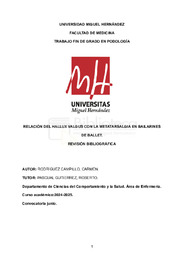Resumen :
Introducción: El ballet es una disciplina con gran exigencia física que afecta de forma significativa a los pies de los bailarines. Esta exigencia genera una carga intensa sobre el pie, especialmente en posiciones como pointe o relevé, lo que puede desencadenar patologías como el hallux valgus y la metatarsalgia, cuya aparición está relacionada con factores biomecánicos, técnicos y estructurales. El hallux valgus es una desviación lateral del primer dedo hacia el resto de los dedos y desviación medial del metatarsiano, alterando la distribución de las presiones plantares. La metatarsalgia es el dolor en la región anterior del pie en la zona de los metatarsianos. La relación entre ambas patologías ha sido poco investigada.
Objetivos: Analizar la relación del hallux valgus y el desarrollo de metatarsalgia.
Material y Métodos:Se realizó una revisión bibliográfica en PubMed utilizando la ecuación de búsqueda utilizada fue: (“Hallux Valgus” OR “bunion”) AND (“ballet” OR “classical dance”), obteniendo 6 artículos que hablan de hallux valgus y metatarsalgia desde distintas perspectivas: biomecánica, anatómica y técnica.
Resultados: Tras la revisión, el hallux valgus altera la distribución de las presiones plantares, aumentando la carga sobre los metatarsianos centrales, favoreciendo la aparición de metatarsalgia. Otros factores como la hipermovilidad, el sexo femenino, el uso zapatilla de punta y errores técnicos agravan esta situación.
Conclusiones: Existe relación entre hallux valgus y metatarsalgia en bailarines adultos. Se requiere más investigación clasificando el tipo de pie (FPI), sobre este tema para profundizar esta relación y mejorar la prevención y el tratamiento de estas lesiones.
Introduction: Ballet is a physically demanding discipline that significantly affects dancers' feet. This demand places intense stress on the foot, especially in positions such as pointe or relevé, which can trigger pathologies such as hallux valgus and metatarsalgia, the onset of which is related to biomechanical, technical, and structural factors. Hallux valgus is a lateral deviation of the big toe toward the other toes and a medial deviation of the metatarsal, altering the distribution of plantar pressure. Metatarsalgia is pain in the anterior region of the foot in the metatarsal area. The relationship between the two pathologies has been little researched.
Objectives: To analyze the relationship between hallux valgus and the development of metatarsalgia.
Matherial and Methods: A literature review was conducted in PubMed using the search equation: (“Hallux Valgus” OR “bunion”) AND (“ballet” OR “classical dance”), yielding six articles that discuss hallux valgus and metatarsalgia from different biomechanical, anatomical, and technical perspectives.
Results: After the review, hallux valgus altered the distribution of plantar pressure, increasing the load on the central metatarsals and favoring the development of metatarsalgia. Other factors such as hypermobility, female gender, wearing pointe shoes, and technical errors aggravate this situation.
Conclusions: There is a relationship between hallux valgus and metatarsalgia in adult dancers. Further research on this topic, classifying foot types (FPI), is needed to further explore this relationship and improve the prevention and treatment of these injuries.
|
 La licencia se describe como: Atribución-NonComercial-NoDerivada 4.0 Internacional.
La licencia se describe como: Atribución-NonComercial-NoDerivada 4.0 Internacional.
.png)
